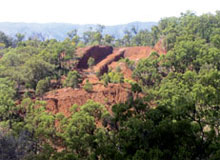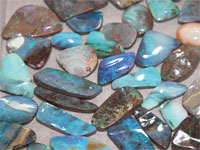Australia - Gems From Down Under
November 13, 06

OPAL
South Australia: The Coober Peedy fields are fairly quiet at present, with about 200 serious active miners. Production is down due to rising expenses. However, demand is steady, with 20-30 regular local and international buyers. There is strong demand for green and milky-gray opal. A new area, 50 kilometers south of a town called Allan’s Rise, is producing good-quality opal in terms of both color and stability, which is popular with buyers. There may be problems for future production if fuel costs continue to rise. Currently, gasoline is priced near U.S. $1 per liter.
A strong community of about 150 miners is working at Mintabie, about 40 percent underground and the balance in open cuts, mostly around the original fields. Production has been down mainly due to mechanical problems. Mostly seam crystal is being produced. Prospective drilling continues. Negotiations are still underway with the South Australian government and local indigenous landholders for an extension of the fields.
Meanwhile, only 40 or so of the 250 miners who used to work at Lambina are still there, partly because a restoration bond has been imposed. The remaining miners report that the future looks good, production continues and there is plenty of area available for prospecting. To quote one miner, “if you hit opal, you hit it big.” Both local and international buyers are flying in weekly.
The Andamooka fields are very quiet at present, with fewer than 50 serious miners.
New South Wales: A large new prospecting area will soon be opened up near Lightning Ridge. Although there has been opposition to such a move by certain green groups and farmers, fears of environmental damage have been met with assurances of larger fines and bonds and more rigorous inspections to ensure correct rehabilitation. The minister of mineral resources said he believed the region needed new areas to prospect, as there have been few new opal finds for many years. Opal production is half of what it was 10 years ago, and there has not been an opal rush since the late 1980s when the Coocoran area was discovered to the west of Lightning Ridge.
Queensland: The Queensland Boulder Opal Fields encompass a vast area centering on the town of Quilpe and extending as far north as Winton and south to Cunamulla. Hundreds of boulder opal miners are scattered over this immense area. Sales of boulder opal have increased markedly over the last twenty years as this unique type of opal gains recognition and popularity internationally. However, the last 12 months have seen slightly lower production levels, as it has been a tough year with rising fuel costs and a slight reduction in demand. Miners, however, are optimistic about the future as this material becomes increasingly recognized for its bright colors and good stability. 
SAPPHIRE
New South Wales: Production is at its lowest level in 40 years. Several longtime mechanized miners have ceased production over the last few years, mainly because of a lack of demand in the international marketplace and rising production costs.
A listed company called Cluff Resources Pacific N. L. is the only miner operating on the Gloucester sapphire and ruby fields, having successfully prospected and developed them over the last few years. Their latest reports indicate that mining is proceeding with gravel carrying much larger stones than previously. Grades of 2 carats per metric ton have been obtained. The largest facet-quality rough gemstones recovered are a 9.8 carat pink, a 9 carat deep green sapphire and a 3.5 carat bright orange sapphire.
The company is marketing cut stones from their production under the name of “Ellerston” (the name of the property where they are mined). A marketing campaign has started featuring their sapphires, especially the pinks in jewelry designed and created both in Australia and internationally, with an emphasis on environmentally sensitive mining methods and the untreated nature of the sapphires.
Queensland: There is only a limited number of machinery miners presently operating in the Central Queensland Fields, however, the number of hand miners is picking up due to the increased number of claims presently being granted. This results from a resolution of the Native Title Agreement in February 2004. There are now estimated to be over 500 hand miners, 150 of whom could be classed as permanent serious miners, and the balance hobbyists and retirees. The production of machine-assisted miners has also seen an increase due to new titles being granted under the agreement. However, these miners are still very handicapped because of the continuing drought and therefore lack of water needed for processing.
There has been a serious lack of international buyers visiting the fields. There has also been virtually no Thai buying activity over the last few years; traditionally, it has been such international buyers who have provided the bulk of income for the fields. This is especially evident in the reduced demand for the “blue” parcels of rough, which normally make up 90 percent of production and income. Larger miners have been stockpiling, awaiting a change in demand. There is still a good local market for “greens,” “yellows” and “parties.”
The future is uncertain. Increased bureaucracy seems to be delaying the granting of leases and claims, and fuel prices are still on the rise.
It has been noticed that there is stronger interest by cut stone buyers in the manner in which a stone has been treated, reflecting an increased awareness of the difference between traditional heat treatments and the more recent treatments involving beryllium. Both rough and cut stones treated with beryllium are commonly appearing for sale on the fields, often without being declared as such. The previously unpopular smaller sizes in greenish-blue and gray-green shades are easily converted to yellows and gold colorless material when treated with beryllium. It is believed that rough thus treated, both locally and in Thailand, is finding its way onto the fields. Serious miners are rightly very concerned that such practices will damage the reputation that the Queensland Fields have for producing some of the world’s best naturally colored greens, yellows and golds.
Tasmania: The Tasmanian State Government has granted a lease to Van Dieman Mines, a company listed on the London Stock Exchange, to mine tin and sapphires in northeast Tasmania.
Although there has never been any large-scale sapphire mining on the island, rough material has often been found by tin miners and fossickers. Interestingly, some of the blue sapphire found there is of a color equal or superior to any found elsewhere in Australia.
OTHER GEMSTONES
Australia is a source for many of the so-called “ornamental” gem materials, and while these don’t normally attract the same interest as the more valuable gems, they are much in demand at present due to the worldwide popularity of gemstone beads.
Materials such as tiger iron, mookaite, chrysoprase, petrified wood, magnesite, and many varieties of jaspers and agates are being exported to Asia for processing.